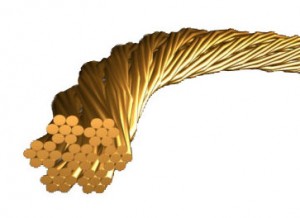The skin effect in audio amps, is it important ?
We’ve already demonstrated in a previous post that using silver instead of copper is of negligible importance in audio amps, and especially in a tube amp. Nonetheless most of those supporting silver in place of copper will raise the Skin Effect argument.
Skin effect is the tendency of an alternating electric current (AC) to distribute itself within a conductor so that the current density -read: the magnitude of the electron flow- near the surface of the conductor is greater than that at its core. The electric current tends to flow at the “skin” of the conductor, at an average depth called the “skin depth”, causing the effective resistance of the conductor to increase with frequency because the greatest part of the conductor (its core) carries little current. For low frequencies, the effect is negligible. For AC current at frequencies high enough that the skin depth is small compared to the conductor size, the skin effect will cause most of the conduction to happen at the conductor’s surface. If the frequency is high enough, the interior of a large conductor doesn’t carry much current, if any at all.
At 60 Hz, the skin depth of a copper wire is about 1/3 inches (8.5 mm). At 60 kHz, the skin depth of copper is about 0.01 inches (0.25 mm). At 6 MHz, the skin depth is about 0.001 inches (25 µm) but this is obviously not our concern, as we’re far from the audio band here. This actually means that, at 60 kHz and lower frequencies, a 0.5 mm diameter wire is almost fully used for electron flow.

Not willing to enter complex calculations, we’ll just say this : if silver is but negligibly better that copper in DC circuits, its (slightly) better resistivity will not give any better results when used in AC circuits and taking skin effect into account.
Should one need to be on the safe side, Litz wire might be used for low level paths, or multi-stranded wires (a rather close -in our application here- less costly version of the later) elsewhere.